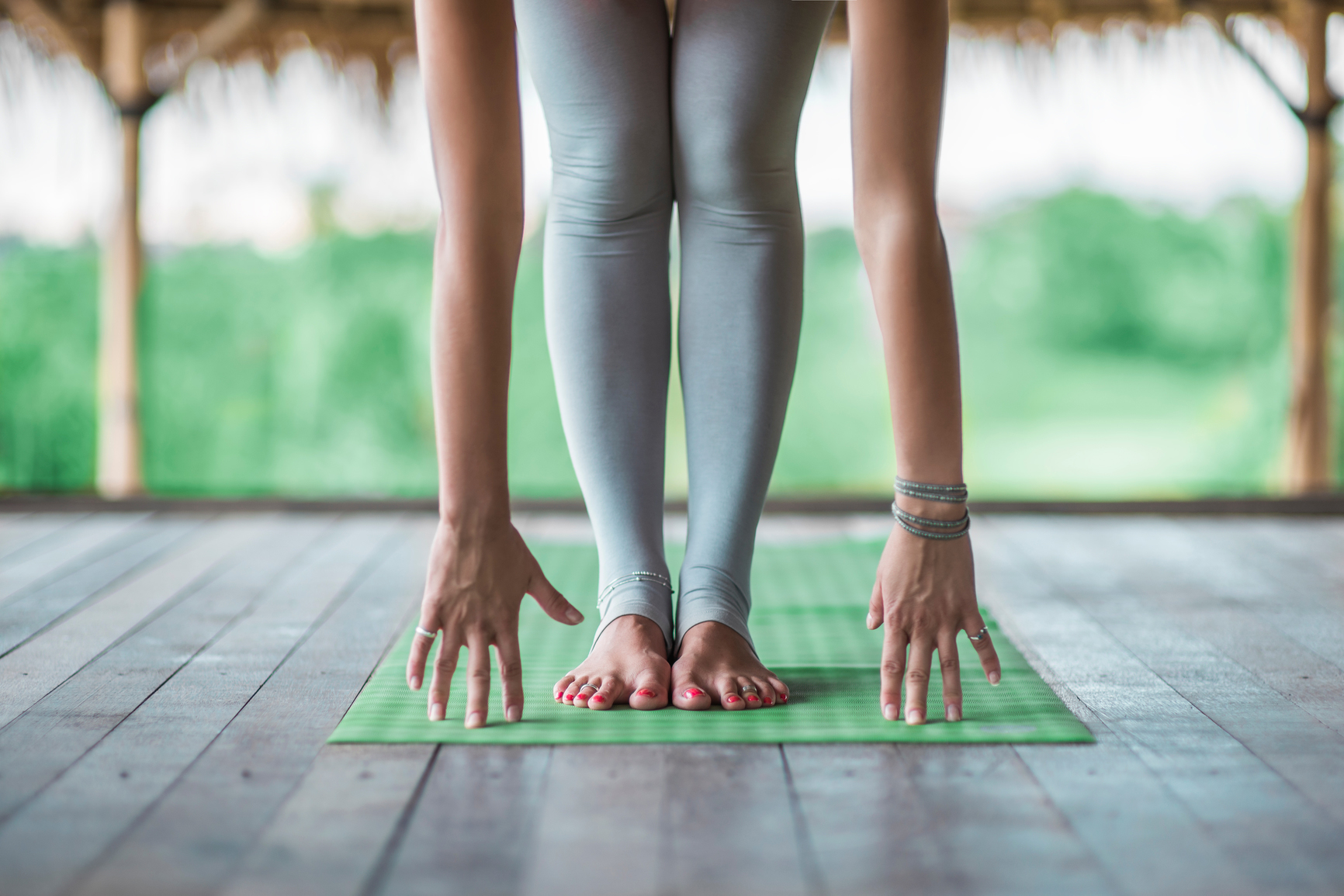The benefits of yoga are widely touted. The ancient practice that links breath and movement is known for improving flexibility, building strength, and, of course, calming the mind. But the benefits of yoga go much further. Yoga sequences can improve nearly every element of the body’s functions. Take, for example, the digestive system. Practicing certain poses and breathing techniques can aid digestion and ease related symptoms such as bloating. Considering the holiday period tends to be a time of indulgence, now is an excellent time to understand how and why yoga may help your digestive system. Plus, learn about the best poses to try.
How does yoga help our digestion?
Regularly practicing yoga is one of the most helpful lifestyle choices we can make in order to have a healthy gut. This is firstly due to the impact of gentle movement. “Gentle movement via yoga promotes regular movement through the gut and can relieve symptoms such as bloating and gas,” Eve Kalinik, a nutritional therapist and author who also works as Gut Health Specialist for Kalla Probiotics, explains. “There are even specific asanas, such as twisted postures, that have a more specific action on the gut and digestive system,” she adds.
Secondly, the use of breath in yoga is extremely powerful when it comes to gut health. “Diaphragmatic (aka ‘belly breathing’) can have a marked impact on reducing stress levels, by activating the parasympathetic nervous system, which is a key part of supporting gut health,” Kalinik explained.

Our breath is particularly powerful in helping our gut because the two are so intrinsically linked. The gut is often known as our ‘second brain’ because of a communication network of nerves that form the gut-brain axis. “Our Vagus Nerve is the longest and most powerful, which originates in the brain stem and connects to the throat, heart, lungs, respiratory diaphragm, and gastrointestinal organs, therefore influencing our digestion. Research has shown that stimulating the Vagus Nerve through practicing yoga is an effective way to stimulate the gut-brain axis and switches on the parasympathetic ‘rest and digest’ mode of our nervous system,” says Gabriella Espinosa, a yoga teacher for the online platform Movement for Modern Life and founder of Women’s Body Wisdom. This breathing plays a key role in reducing stress and anxiety, which are often the drivers of digestive issues.
Practicing yoga also helps with how we see our bodies and helps move towards body acceptance. This can be good for our digestive systems. “Yoga, breathwork, and meditation are all practices that allow increased awareness of your physical, mental, emotional, and spiritual state which can improve how you feel about your body. This can help put you in a better frame of mind to make better food choices that influence your gut health,” Espinosa points out.
What about meditation?
Meditation is a core element of yoga. Much like the physical side of the practice, regularly meditating can also improve gut health. In a similar way to breathing, meditating activates the parasympathetic or ‘rest and digest’ response. “This has a positive impact on the gut-brain connection and a whole host of direct digestive symptoms,” Kalinik explained. This is the opposite of what happens when we produce cortisol, the stress hormone.
“Our response to stress and anxiety is often quick, shallow breathing, which can compromise gut health by restricting blood flow to our digestive system, interfering with its normal functions. In meditation, we bring awareness to the breath which is an effective way to encourage the body to relax by lowering heart rate, reducing blood pressure, and reducing muscle tension,” notes Espinosa. “The more we can do to counterbalance this with meditation practices that switch on our ‘rest and digest’ mode, the better for our gut,” Kalinik clarifies.
Try Yoga for Digestion
Gabriella Espinosa recommends her favorite poses for improving digestion.
Diaphragmatic Breathing
The diaphragm is the main muscle responsible for respiration. When you breathe fully with the diaphragm, it gently massages the stomach organs which can reduce abdominal pain and support digestion.
How To:
- Sit upright in a chair and place both hands on your abdomen
- Bring your attention to your breath noticing the quality and movements of your breath
- Breathe in slowly through your nose, letting the air in deeply, towards your lower belly
- Notice as you inhale, the abdomen naturally expands
- Exhale, the abdomen softly floats back towards the spine
- Continue gently expanding the abdomen on the inhale and softly bringing the abdomen back on the exhale supporting the natural movement of the diaphragm
- Repeat for 5-10 minutes and practice a few times throughout your day
Cat-Cow
This allows us to access and mobilize the areas that stimulate the Vagus Nerve, which positively influences digestion and switches on the parasympathetic mode of our nervous system. The synchronization of breath and movement also relieves emotional stress and calms the mind.
How To:
- Begin in a tabletop position (all fours), keeping wrists under your shoulders and knees underneath your hips in a neutral spine
- As you inhale, move into cow pose, gently opening through your chest and throat press your chest forward allowing your belly to drop and your tailbone to lift up. Raise your head and relax your shoulders away from your ears
- As you exhale, come into cat pose, press through the hands, round your spine, draw your tailbone under and gently move your chin towards the chest
- Go back and forth between Cow and Cat on each inhale and exhale, matching your movements to your breath
- Do this for 5-10 breaths keeping your weight evenly distributed between your hands and knees
- After your final exhale, end in tabletop position
Crocodile Pose
This pose is deeply relaxing for the whole body and gently stretches and relaxes the paraspinal muscles, strengthens the respiratory diaphragm, and stimulates the connective tissue of the belly which activates the vagus nerve, lowering the heart rate and shifting us into ‘rest and digest’ mode.
How To:
- Fold a yoga blanket once the long way, smooth out the edges, and then fold two more times the long way
- As you come to lie face down place your abdomen/navel over the centre of the folded blanket, your ribs just over the top edge of the blanket, and your hips below the bottom edge
- Place your legs a comfortable distance apart, turning your toes either in or out. Fold your arms, rest your forehead on your forearms and relax your jaw
- Bring your awareness to your breath, noticing how the belly expands into the blanket on the inhale and softly moves away on the exhale. The belly is gently being massaged by the folds of the blanket
- Gradually make the exhale a little longer than your inhale to further stimulate the vagus nerve and move you into deeper relaxation
- Do not perform during pregnancy or if you have a condition in which abdominal pressure is uncomfortable
Chair Twist
Twists are a wonderful way to create movement in and around our spinal muscles and digestive organs, stretching the muscles of the back and gently stimulating the gastrointestinal organs. The twisting action also stimulates blood circulation and releases tension in the muscles of the abdomen, as well as creating an intra-abdominal compression, benefitting the digestive organs with fresh blood flow and oxygen to support digestion.
How To:
- Begin standing up tall with your feet together. Raise your arms overhead and bend your knees, lift your chest and arms forward away from the thighs, so that the spine and arms are parallel to the floor.
- Raise your sitting bones upwards, you will feel your thighs working hard in this half-squat position. Draw your buttocks towards your heels and bring your palms together in front of the chest.
- Rotate your chest and upper body to the right. Press your left elbow over and into the outer knee. Try to position your hands in front of the heart center. Make sure your knees are still in line and haven’t shifted.
- Move your body weight onto your heels. Release and repeat on the other side.
Garland Pose
Garland Pose is a form of yogic squat that places you in the optimal position to facilitate elimination. It also increases the blood flow to your kidneys and intestines and creates space in the lower back area and stretches and relaxes the pelvic floor. All this combined reduces stagnation, bloating and helps to stimulate our digestive flow.
How To:
- Step the feet a little wider than the hips, toes pointing slightly out
- Come into a squat and bring your elbows to the inside of your knees, palms together at the chest
- Keep your heels on the floor or place a rolled-up blanket/mat under your heels so they are supported. You can also add support under your buttocks (blocks or a stack of books)
- Make sure the knees are pointing in the direction of the toes and try not to ‘collapse’ into the chest
- Separate your thighs, press your elbows against your inner knees and bring your palms together. Soften the belly, allowing the breath to flow freely into your belly, feeling its movements as it presses into the thighs
- To come out of the pose, release the hands and press them onto the thighs, and root into the feet as you slowly rise up to standing
Forward Fold
The forward fold action of this pose gently massages the digestive organs such as the liver, spleen, pancreas, and intestines. This stimulation improves blood circulation to the area, offering the best functional capacity to these organs.
How To:
- Start in Tadasana/Mountain pose
- Inhale as you raise your arms
- As you exhale, engage your thighs, pull the belly in and up deep from the pelvic floor, and bend forward, hinging from the hips
- Place your hands/fingertips on the floor, in front of your feet or next to your feet, or hold onto the back of your ankles or calves
- Keep your hips over your heels as you press your heels into the floor. Roll the top of your inner thighs slightly in
- Let your head hang, keeping the neck relaxed
- Lengthen your spine as you inhale. Soften deeper into the pose as you exhale
Knees to Chest
This pose focuses on placing gentle stimulating pressure on the abdomen to release any tension. Gentle pressure massages the abdomen along with the other intestinal organ, bringing increased blood flow and oxygen to all of the muscles in the digestive system.
How To:
- Begin by laying down on your back
- Bend and hug one knee at a time into the chest
- Hold the front of the shin on the bent leg, pressing it into your chest
- Breathe evenly, hold for 5-10 breaths
- Add a gentle rocking side to side
- Release legs, straighten them, and relax
We only recommend products we have independently researched, tested, and loved. If you purchase a product found through our links, Sunday Edit may earn an affiliate commission.







